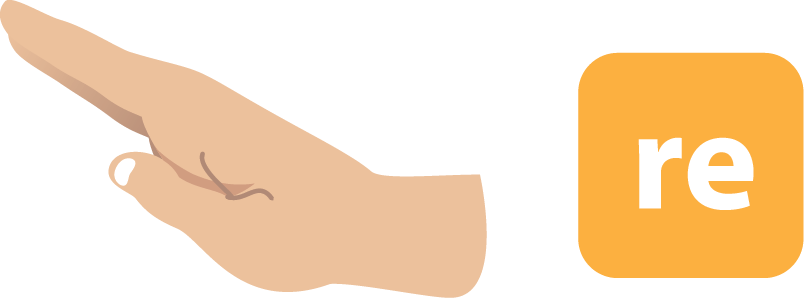Y2. Lesson 7. New note - re
Prior learning: do, so, mi, la
Duration: 30 minutes
Materials:
Keywords: Beat, rhythm, singing, chanting, partners, rhymes, circle games.
Difficulty: ![]()
Prepare
Trichord mi-re-do
Present
Re
Practise
Forte & piano
 Melodic development
Melodic development
![]() Students discover a new note, re.
Students discover a new note, re.
- Lead the class in singing Hot Cross Buns.
- Ask students to sing and to put the high note on their heads, the middle note on their shoulders and the low note on their knees (or laps).
- Point and follow the melodic contour as the class sings the rhythm syllables.
- Ask the class how many beats were in the first phrase. [4]
- Ask how many notes there were in that phrase. [3]
- Ask whether the notes moved up or down. [down]
- Ask whether the notes moved in skips or steps. [steps]
- Teach that the note between do and mi is called re.
- Demonstrate the hand sign for re and ask the class to show you.
- Sing the song again using the solfa.

 Rhythmic development
Rhythmic development
![]() Students are challenged to finish the rhythm patterns.
Students are challenged to finish the rhythm patterns.
- Project the worksheet on the board or print it.
- Ask students to fill in the missing rhythm syllables by saying the correct answer.
- Ask how many beats are in each line. [4]
- Ask how many beats are on the question mark. [1]
- Using the first line, choose a student to say the syllable and ask what the missing syllable could be.
- Answers should be ti-ti or ta.
- The student should choose the syllable and repeat the first line.
- Repeat the process with another student on the next line.
 Creative movement
Creative movement
![]() Students perform actions, sing and stamp the beat.
Students perform actions, sing and stamp the beat.
Dr James Cuskelly and students of St Joseph's School, Stanthorpe.
- Students form a circle.
- A student is chosen to march around the outside of the circle.
- Lead the class in singing the song and stamping to the beat.
- On the words "back, back zero", the student will bump backwards into the nearest student in the circle.
- On the words "side, side zero", the student will bump sideways into the same student.
- On the words " front, front zero", the student will bump frontwise into the same student.
- On the words 'tap your loving zero",' the student will gently push their hands against the other student's hands.
- The game is repeated with another chosen student patrolling the circle's perimeter.
 Listening
Listening
![]() Students refresh their knowledge of forte and piano.
Students refresh their knowledge of forte and piano.
- Students are seated and attentive.
- Print and distribute the flashcards.
- Explain that the class will hear a piece of music that they may have heard before.
- When the music is quiet, they should hold up the sign for piano, p.
- When the music is loud, they should hold up the sign for forte, f.
- This piece of music always causes students to jump at the end!
 Visual learning
Visual learning
![]() Students discover where re is paced on a tone ladder and traditional staff.
Students discover where re is paced on a tone ladder and traditional staff.
- Project the graphics (toggle full screen) on the board.
- Teach that If mi is on a line and do is on the line below, re is in the space between.
- If mi is in a space and do is in the space below, re is on the line between.
 Instruments
Instruments
![]() Students use tuned and untuned percussion in this Orff arrangement.
Students use tuned and untuned percussion in this Orff arrangement.
- This arrangement was first described in Year 1 and uses a soprano glockenspiel and xylophone, an alto marimba, and a hand drum.
- Divide the class into four groups, one group for each instrument.
- Distribute instruments to each group. If there are insufficient for every student, then turns should be taken, so no one misses out on playing.
- Teach the melody on the xylophone to the appropriate group slowly and with a steady beat. It may be helpful to count the four beats.
- When the above is secure, teach the glockenspiel part, counting aloud and playing the two notes in octaves. Use single notes if students are not familiar enough with the instrument.
- Demonstrate the marimba part when the class is ready, followed by the drum part. Again, counting in fours is a great help.
- When every student with an instrument knows their part, then ask the class to play the song after a count of four.
- For those students without instruments, ask them to sing the song.
- Repeat with other students if necessary, as time permits.
 Part work
Part work
![]() Students sing and clap an ostinato pattern.
Students sing and clap an ostinato pattern.
Dr James Cuskelly and students of St Joseph's School, Stanthorpe.
- Students are seated and attentive.
- Ask the class about the meaning of ostinato. [repeated pattern]
- Draw a two-beat ostinato pattern on the board using stick notation.
- Lead the class in clapping the ostinato pattern.
- Explain that students will sing Kangaroo and clap the ostinato pattern.
- Lead the class and monitor rhythmic accuracy and tuneful singing voices.
Students section




 Assess
Assess
Suggested lessons
Y1. Beat II

Y1. Beat III

Y1. Beat IV

